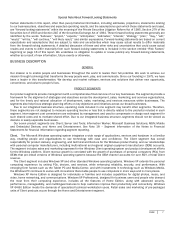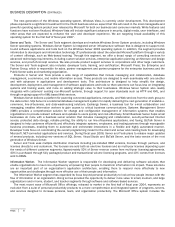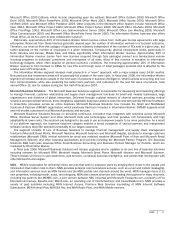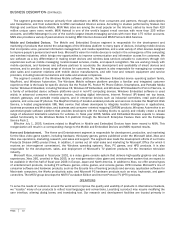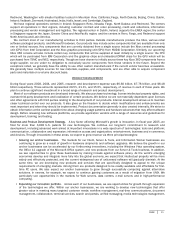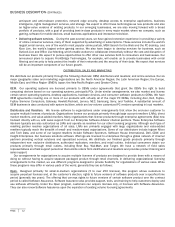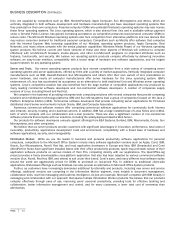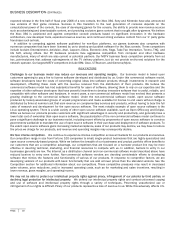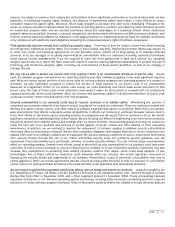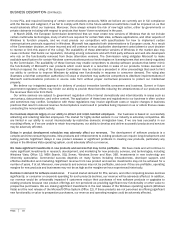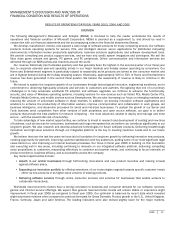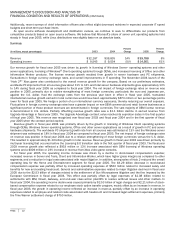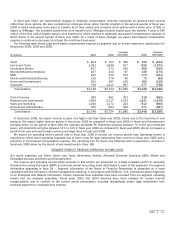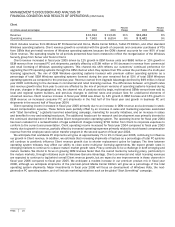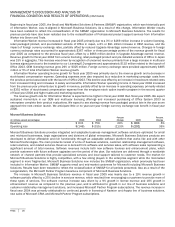Microsoft 2005 Annual Report Download - page 18
Download and view the complete annual report
Please find page 18 of the 2005 Microsoft annual report below. You can navigate through the pages in the report by either clicking on the pages listed below, or by using the keyword search tool below to find specific information within the annual report.
PAGE 17
revenue, the impact on revenue from outside the United States is more significant, particularly in countries where laws are less
protective of intellectual property rights. Similarly, the absence of harmonized patent laws makes it more difficult to ensure
consistent respect for patent rights. Moreover, future legal changes could make this even more challenging. Throughout the
world, we actively educate consumers about the benefits of licensing genuine products and obtaining indemnification benefits
for intellectual property risks, and we educate lawmakers about the advantages of a business climate where intellectual
property rights are protected. However, continued educational and enforcement efforts may not affect revenue positively, and
revenue could be adversely affected by reductions in the legal protection for intellectual property rights for software developers
or by compliance with additional legal obligations impacting the intellectual property rights of software developers.
Third parties may claim we infringe their intellectual property rights. From time to time we receive notices from others claiming
we infringe their intellectual property rights. The number of these claims may grow. Responding to these claims may require us
to enter into royalty and licensing agreements on less favorable terms, require us to stop selling or to redesign affected
products, or to pay damages or to satisfy indemnification commitments with our customers including contractual provisions
under various license arrangements. If we are required to enter into such agreements or take such actions, our operating
margins may decline as a result. We have made and expect to continue making significant expenditures to acquire the use of
technology and intellectual property rights, including via cross-licenses of broad patent portfolios, as part of our strategy to
manage this risk.
We may not be able to protect our source code from copying if there is an unauthorized disclosure of source code. Source
code, the detailed program commands for our operating systems and other software programs, is the most significant asset we
own. While we license certain portions of our source code for various software programs and operating systems to a number of
licensees, we take significant measures to protect the secrecy of large portions of our source code. If an unauthorized
disclosure of a significant portion of our source code occurs, we could potentially lose future trade secret protection for that
source code. The loss of future trade secret protection could make it easier for third parties to compete with our products by
copying functionality, which could adversely affect our revenue and operating margins. Unauthorized disclosure of source code
could also increase certain risks described in the next paragraph.
Security vulnerabilities in our products could lead to reduced revenues or to liability claims. Maintaining the security of
computers and computer networks is an issue of critical importance for us and our customers. There are malicious hackers who
develop and deploy viruses, worms, and other malicious software programs that attack our products. While this is an industry-
wide phenomenon that affects computers across all platforms, it affects our products in particular because hackers tend to
focus their efforts on the most popular operating systems and programs and we expect them to continue to do so. We devote
significant resources to addressing these critical issues. We are focusing our efforts on engineering even more secure products,
enhancing security and reliability options and settings when we deliver products, and providing guidance to help our customers
make the best use of our products and services to protect against computer viruses and other attacks on their computing
environment. In addition, we are working to improve the deployment of software updates to address security vulnerabilities
discovered after our products are released. We are also investing in mitigation technologies that help to secure customers from
attacks even when such software updates are not deployed. We are also advising customers on how to help protect themselves
from security threats through the use of our online automated security tools, our published security guidance, and the
deployment of security software such as firewalls, antivirus, and other security software. The cost of these steps could adversely
affect our operating margins. Despite these efforts, actual or perceived security vulnerabilities in our products could lead some
customers to seek to return products, to reduce or delay future purchases, or to use competitive products. Customers may also
increase their expenditures on protecting their existing computer systems from attack, which could delay adoption of new
technologies. Any of these actions by customers could adversely affect our revenue. We devote significant resources to
improving the security design and engineering of our software. Nevertheless, actual or perceived vulnerabilities may lead to
claims against us. While our license agreements typically contain provisions that eliminate or limit our exposure to such liability
claims, there is no assurance these provisions will be held effective under applicable laws and judicial decisions.
We are subject to government regulatory activity that affects how we design and market our products. Lawsuits brought by the
U.S. Department of Justice, 18 states, and the District of Columbia in two separate actions were resolved through a Consent
Decree that took effect in November 2001 and a Final Judgment entered in November 2002. These proceedings imposed
regulatory constraints on our Windows operating system businesses, including limits on certain contracting practices, required
disclosure of certain software program interfaces, limits on Microsoft’s ability to ensure the visibility of certain Windows features


